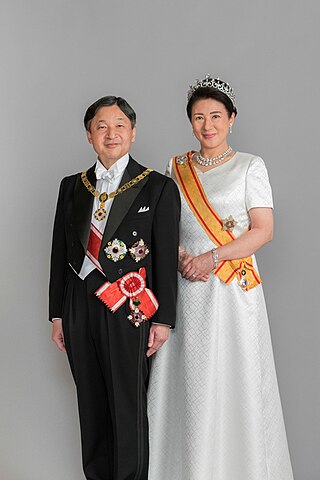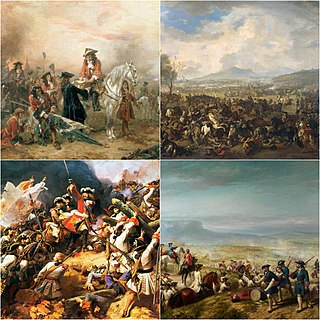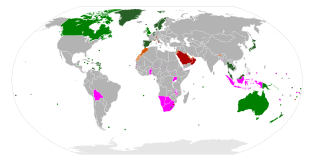
The word emperor can mean the male ruler of an empire. Empress, the female equivalent, may indicate an emperor's wife, mother/grandmother, or a woman who rules in her own right and name. Emperors are generally recognized to be of the highest monarchic honour and rank, surpassing king. In Europe, the title of Emperor has been used since the Middle Ages, considered in those times equal or almost equal in dignity to that of Pope due to the latter's position as visible head of the Church and spiritual leader of the Catholic part of Western Europe. The emperor of Japan is the only currently reigning monarch whose title is translated into English as "Emperor".

The history of Spain dates to contact between the pre-Roman peoples of the Mediterranean coast of the Iberian Peninsula with the Greeks and Phoenicians. During Classical Antiquity, the peninsula was the site of multiple successive colonizations of Greeks, Carthaginians, and Romans. Native peoples of the peninsula, such as the Tartessos, intermingled with the colonizers to create a uniquely Iberian culture. The Romans referred to the entire peninsula as Hispania, from which the name "Spain" originates. As was the rest of the Western Roman Empire, Spain was subject to numerous invasions of Germanic tribes during the 4th and 5th centuries AD, resulting in the end of Roman rule and the establishment of Germanic kingdoms, marking the beginning of the Middle Ages in Spain.

The House of Habsburg, also known as the House of Austria, was one of the most prominent and important dynasties in European history.

The War of the Spanish Succession was a European great power conflict fought between 1701 and 1714. The immediate cause was the death of the childless Charles II of Spain in November 1700, which led to a struggle for control of the Spanish Empire between supporters of the French Bourbons and the Habsburgs. Charles named his heir as Philip of Anjou, a grandson of Louis XIV of France, whose claim was backed by France and most of Spain. His rival, Archduke Charles of Austria, was supported by the Grand Alliance, whose primary members included Austria, the Dutch Republic, and Great Britain. Significant related conflicts include the 1700 to 1721 Great Northern War and Queen Anne's War.

The Low Countries, historically also known as the Netherlands, is a coastal lowland region in Northwestern Europe forming the lower basin of the Rhine–Meuse–Scheldt delta and consisting today of the three modern "Benelux" countries: Belgium, Luxembourg, and the Netherlands. Geographically and historically, the area can also include parts of France and the German regions of East Frisia, Guelders and Cleves. During the Middle Ages, the Low Countries were divided into numerous semi-independent principalities.

The political history of France covers the history of political movements and systems of government in the nation of France, from the earliest stages of the history of France until the present day. This political history might be considered to start with the formation of the Kingdom of France, and continue until the present day.

Early modern Europe, also referred to as the post-medieval period, is the period of European history between the end of the Middle Ages and the beginning of the Industrial Revolution, roughly the mid 15th century to the late 18th century. Historians variously mark the beginning of the early modern period with the invention of moveable type printing in the 1450s, the Fall of Constantinople and end of the Hundred Years' War in 1453, the end of the Wars of the Roses in 1485, the beginning of the High Renaissance in Italy in the 1490s, the end of the Reconquista and subsequent voyages of Christopher Columbus to the Americas in 1492, or the start of the Protestant Reformation in 1517. The precise dates of its end point also vary and are usually linked with either the start of the French Revolution in 1789 or with the more vaguely defined beginning of the Industrial Revolution in late 18th century England.

A viceroy is an official who reigns over a polity in the name of and as the representative of the monarch of the territory.

The Duchy of Parma and Piacenza was an Italian state created in 1545 and located in northern Italy, in the current region of Emilia-Romagna.

The Habsburg monarchy, also known as Habsburg Empire, or Habsburg Realm, was the collection of empires, kingdoms, duchies, counties and other polities that were ruled by the House of Habsburg. From the 18th century it is also referred to as the Austrian monarchy or the Danubian monarchy.

The Kingdom of France in the early modern period, from the Renaissance to the Revolution (1789–1804), was a monarchy ruled by the House of Bourbon. This corresponds to the so-called Ancien Régime. The territory of France during this period increased until it included essentially the extent of the modern country, and it also included the territories of the first French colonial empire overseas.
The ideas of the Age of Enlightenment came to Spain in the 18th century with the new Bourbon dynasty, following the death of the last Habsburg monarch, Charles II, in 1700. The period of reform and 'enlightened despotism' under the eighteenth-century Bourbons focused on centralizing and modernizing the Spanish government, and improvement of infrastructure, beginning with the rule of King Charles III and the work of his minister, José Moñino, count of Floridablanca. In the political and economic sphere, the crown implemented a series of changes, collectively known as the Bourbon reforms, which were aimed at making the overseas empire more prosperous to the benefit of Spain.

The Kingdom of France is the historiographical name or umbrella term given to various political entities of France in the medieval and early modern period. It was one of the most powerful states in Europe from the High Middle Ages to 1848 during its dissolution. It was also an early colonial power, with colonies in Asia and Africa, and the largest being New France in North America centred around the Great Lakes.

The word Kleinstaaterei is a pejorative term coined in the early nineteenth century to denote the territorial fragmentation of Germany. While the term referred primarily to the territorial fragmentation of the German Confederation, it is also applied by extension to the even more extreme territorial fragmentation of the Holy Roman Empire. In this period, Germany was split into a great number of nearly sovereign small and medium-sized secular and ecclesiastical principalities and free imperial cities, some of which were little larger than a single town or the surrounding grounds of the monastery of an Imperial abbey. Estimates of the total number of German states at any time during the 18th century vary, ranging from 294 to 348, or more. However, the number of states rapidly decreased with the onset of German mediatisation in the early 19th century.

The term French–Habsburg rivalry describes the rivalry between France and the House of Habsburg. The Habsburgs headed an expansive and evolving empire that included, at various times, the Holy Roman Empire, the Spanish Empire, Austria, Bohemia and Hungary from the Diet of Augsburg in the High Middle Ages until the dissolution of the monarchy following World War I in the late modern period.

Monarchism is the advocacy of the system of monarchy or monarchical rule. A monarchist is an individual who supports this form of government independently of any specific monarch, whereas one who supports a particular monarch is a royalist. Conversely, the opposition to monarchical rule is referred to as republicanism.
World domination is a hypothetical power structure, either achieved or aspired to, in which a single political authority holds power over all or virtually all the inhabitants of Earth. Various individuals or regimes have tried to achieve this goal throughout history, without ever attaining it. The theme has often been used in works of fiction, particularly in political fiction, as well as in conspiracy theories, particularly those fearing the development of a "New World Order" involving a world government of a totalitarian nature.

International relations from 1648 to 1814 covers the major interactions of the nations of Europe, as well as the other continents, with emphasis on diplomacy, warfare, migration, and cultural interactions, from the Peace of Westphalia to the Congress of Vienna.

The Kingdom of Spain entered a new era with the death of Charles II, the last Spanish Habsburg monarch, who died childless in 1700. The War of the Spanish Succession was fought between proponents of a Bourbon prince, Philip of Anjou, and the Austrian Habsburg claimant, Archduke Charles. After the wars were ended with the Peace of Utrecht, Philip V's rule began in 1715, although he had to renounce his place in the succession of the French throne.

The decline of Spain was the gradual process of financial and military exhaustion and attrition and suffered by metropolitan Spain throughout the 17th century, in particular when viewed in comparison with ascendant rival powers of France and England. The decline occurred during the reigns of the last kings of Habsburg Spain: Philip III, Philip IV and Charles II. Concurrent with the military and economic issues there was a depopulation in metropolitan Spain. The Spanish decline was a historical process simultaneous to the purpoted general crisis of the 17th century that swept most of Eurasia, but which was especially serious for Spain. It was so debilitating that Spain went from being the hegemonic power in Europe, with the largest economy on the continent in the mid-1500s, to becoming a financially exhausted, second-rate power by the end of the 1600s. Contrary to metropolitan Spain there was not an equivalent decline in Spanish America where Spain successfully defended its dominions and both the cities and the general population grew.

















